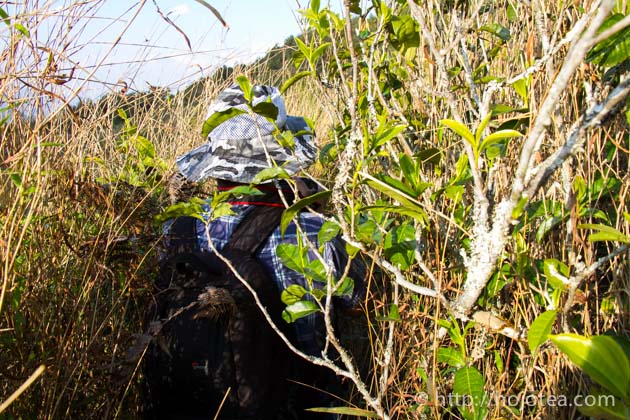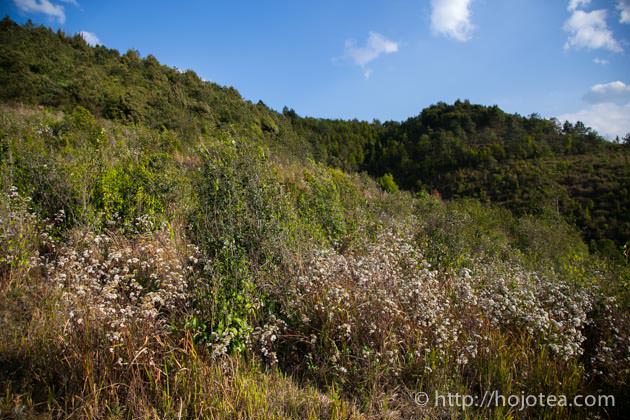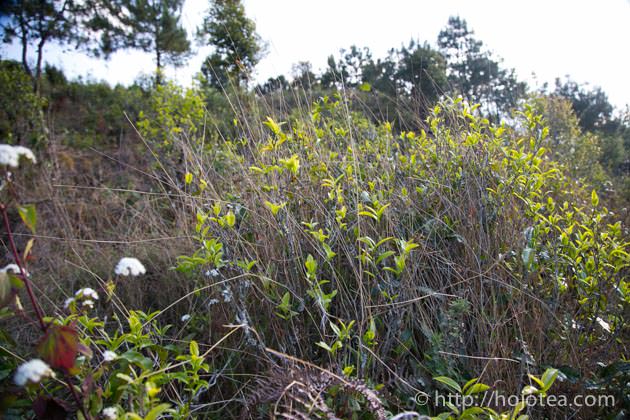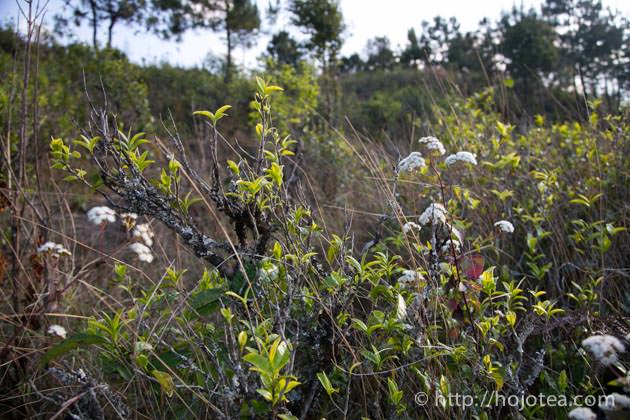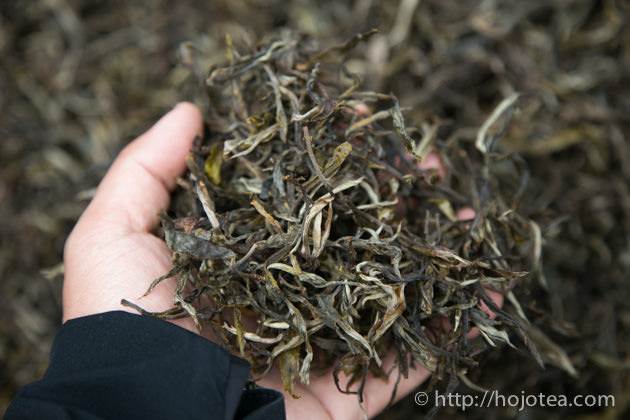- HOME >
- How to choose quality tea
Natural farming tea garden that is beyond agriculture

As compared to other places in China, every year I spend a lot more time in Yunnan. The reason is simple. In the entire world of tea, besides Yunnan, it is hard to find another place that is so rich in the natural-farmed tea. In Yunnan, we have a bountiful opportunity to explore the tea grown with eco-friendly style. When we mentioned Yunnan, many people may associate it with the pu-erh tea. However, it is the general idea. If we spend some time and carefully look for the manufacturer, there are skilled-manufacturers making the green tea, white tea, black tea and even oolong tea too.
Visiting ultimate natural farming garden
From my point of view, the natural farming refers to the tea trees as being part of surrounding ecology system. During my one-month stay in Yunnan, I have visited many natural-farmed tea gardens. But I would like to introduce one particular tea garden which has left me a very deep impression. The garden belongs to Mr. Liu, one of my important tea manufacturers. He loves natural farming. But his style is somehow a little extreme. In his tea garden, he gives no fertilizer, no pesticide and no pruning. In addition, he never even conducts any weeding at his tea garden.
Visiting natural farming tea garden was like an expedition
In fact, there are many styles in so-called natural farming. Some of them are fairly organized and some of them are very wild. Mr. Liu’s tea garden turned so wild style that it is hard for me to tell if I should call it natural farming or back to the wild. His tea garden was completely assimilated with the surrounding nature. I followed Mr. Liu and walked for about 1 hour to reach the foot of his tea garden. It was located at the altitude around 2000-2100m. The slope was very steep and fully covered with bush. We needed to sometimes walk like an animal, sliding down and jump over. It was like an expedition.
Naturally farmed tea leaves are shining in golden colour
When Mr. Liu pointed where his tea garden is situated, it looks nothing but just ordinary mountain. We could only notice the bushes and some taller trees and we could barely see any tea tree. It took us another half an hour walk at the slope to reach the location where some tea trees were scattered. Tea tree was grown independently without the care of human. The tea leaf was yellow colour and it was shining. Usually, when uses fertilizer, the tea tree produces very green and big leaves. The fertilizer increases the growing speed of tea. Subsequently tea has to increase the speed of photosynthesis in order to support the fast growing speed. This is how the more number of chlorophylls is composed and tealeaf turns very green in colour. The naturally farmed tea grows slowly. As a result, it is yellow like the colour of ripen banana skin. The tea leaves were shining like gold; it is simply beautiful!

It is easy to tell whether tea is naturally farmed or not. Usually, naturally farmed tea produces relatively smaller leaf. In addition, the vein on the leaf is slimmer and the colour of leaf is more yellowish. Besides, the distance of tea leaves on the twig is closer to each other. It shows that tea is growing slowly.
Tea grows very fast when fertilizer is used. As a result, the distance between the 1st leaf and 2nd leaf or 3rd leaf is longer.
We bought tea from the entire garden of Mr. Liu.
Mao-cha also looks a little yellowish[/caption]
When I was walking around the Mr. Liu’s tea garden, I kept plucking and eating the fresh tea leaves. To my surprise, it is not bitter at all. It gives super deep aftertaste and the sweetish taste lingers down my throat for a long time. I immediately decided to purchase all teas available from this tea garden. Due to the extremely wild environment, the access to this area was easier said than done; Mr. Liu had a difficulty to allocate the tea pluckers as they normally prefer a more “tamed” environment. At last, he managed to arrange some people for plucking since we made a firm confirmation. The mao-cha after the sunshine drying appeared yellowish colour, follow the colour of the fresh tea leaf.

Since the tea is collected from the tea garden owned by Mr. Liu, it is named as Liu Jia Raw Pu-erh Tea.
Related Articles
How to get the latest update on HOJO Tea?
1. Follow Twitter, 2. Click "Like" on Facebook, and 3. Subscribe in newsletter. You can have the latest tea news from HOJO Tea.
 Subscribe the Newsletter to enjoy the privileges
Subscribe the Newsletter to enjoy the privileges- You may receive a free sample upon purchase, or you may have the priority to purchase special products. So please remember to subscribe our newsletter as well as the social network.
- New Release of High Mountain White Tea
- We are pleased to introduce our High Mountain White Tea, sourced from a unique tea garden with two key features: 1. Located at an altitude of 2200-2300m2. Completely wild and untended The ideal natural conditions of this garden result in tea of exceptional quality, offering a pure and gentle, nourishing taste. High Altitude and Wild …
- New Release of Da Xue Shan Wild White Tea 2024
- We have released the 2024 Da Xue Shan Wild White Tea Loose Leaf. This tea was produced under our direct supervision during our stay in Yunnan Province, ensuring meticulous production management on site. Definition of Wild Tea in Yunnan Province People in Yunnan strongly associate Camellia taliensis with wild tea, regardless of where it is …
NEW ARTICLES
 Why Do Some Teas Taste Astringent? Exploring the Causes and Mechanisms of Astringency
Why Do Some Teas Taste Astringent? Exploring the Causes and Mechanisms of Astringency- Tea can range from having no noticeable astringency to possessing a very strong one. What causes this astringency? This article explores the causes and mechanisms behind astringency in tea. Causes of Astringency Astringency arises from the binding of tea components to proteins in the oral cavity, creating a sensation of tightness or dryness. The tongue …
 The Impact of Heat Sources on Tea Flavor
The Impact of Heat Sources on Tea Flavor- It is widely recognized that the material of a kettle plays an important role in shaping the taste of water for brewing tea. Yet, an often overlooked but equally significant factor is the type of heat source used to boil the water. Different heat sources, whether gas, electric, charcoal, or wood fire, can impart distinct …
 New Release of High Mountain White Tea
New Release of High Mountain White Tea- We are pleased to introduce our High Mountain White Tea, sourced from a unique tea garden with two key features: 1. Located at an altitude of 2200-2300m2. Completely wild and untended The ideal natural conditions of this garden result in tea of exceptional quality, offering a pure and gentle, nourishing taste. High Altitude and Wild …
 New Release of Da Xue Shan Wild White Tea 2024
New Release of Da Xue Shan Wild White Tea 2024- We have released the 2024 Da Xue Shan Wild White Tea Loose Leaf. This tea was produced under our direct supervision during our stay in Yunnan Province, ensuring meticulous production management on site. Definition of Wild Tea in Yunnan Province People in Yunnan strongly associate Camellia taliensis with wild tea, regardless of where it is …
 New Release of Wild Pu-erh Jasmine Pearl
New Release of Wild Pu-erh Jasmine Pearl- Out of curiosity, we decided to create a jasmine tea based on Da Xue Shan Wild Raw Tea. This resulted in an exceptionally rare tea, not only in Japan but also in China. Custom Production Network for Jasmine Tea At our store, we source various types of base teas from different regions during the spring. …
 2024 Overview: Our Yunnan White Tea Quality, Process, and Weather Insights
2024 Overview: Our Yunnan White Tea Quality, Process, and Weather Insights- One of the teas we’ve been focusing on in Yunnan Province is white tea. Historically white tea has been produced in both Fujian Province and Yunnan Province for a long time. While white tea from Fujian Province is well-managed during processing, we are dissatisfied with the quality of the raw materials due to the use …
 Yunnan’s Hospitality Culture: Expressed Through Meals
Yunnan’s Hospitality Culture: Expressed Through Meals- In China, as a form of greeting, it’s common to say “你吃饭了吗?” which means “Have you eaten?” However, in Yunnan Province, the phrase “吃饭” is often used in various situations, more like “Eat, eat,” serving as an invitation to share a meal. Yet, with prolonged exposure to Yunnan, one comes to understand that these meal …
 In Search of Wild Tea: Exploring Mountain Villages in Southwest Lincang, Yunnan
In Search of Wild Tea: Exploring Mountain Villages in Southwest Lincang, Yunnan- We are currently sourcing tea in the southwestern part of Lincang City, Yunnan Province. One of the crucial products for us is wild tea. While tea processing is important, securing the raw materials poses the biggest challenge. Recently, we received information about a new location where wild tea supposedly grows. To verify this, we visited …
 New Release of Anxi Traditional Oolong
New Release of Anxi Traditional Oolong- Anxi, located in Fujian province, China, is celebrated for its Tie Guan Yin tea. However, the Traditional Anxi Oolong from this region boasts a unique fruity aroma, distinguishing it from Tie Guan Yin. Anxi: A Renowned Hub for Oolong Tea Production in China Fujian Province, renowned for its rich tea heritage, boasts several prominent tea-producing …
 Yunnan 2024 Spring Tea Sourcing
Yunnan 2024 Spring Tea Sourcing- Yunnan Province is globally renowned for the exceptional quality of its tea leaves. However, lax production management often presents challenges in achieving the desired tea quality when relying solely on pre-made teas. To address this issue, we have committed to remaining on-site throughout the spring season to closely monitor tea production. We are meticulously inspecting …
Shop Info

Address:Lot No. T-215, 3rd Floor, The Gardens Mall, Mid Valley City, Lingkaran Syed Putra, 59200 Kuala Lumpur
Tel: +603-2287-4537
Business Hour: 10am to 10pm
Category
- New Arrival at HOJO Online Shop
- Featured Articles
- Newsletter
- Types of Tea
- Origin of Tea
- Teapot and Tea Equipment
- Tea Column
- How to enjoy tea
- Tea Processing
- How to choose quality tea
- Tea constituents and functional effect
- Safety of Tea
- Foods
- Tea Business Operation
- Hobby and Outdoor Activity
- Ranking of Tea
- Video
- FAQ
- Media Release
Profile

- AKIRA HOJO
- I invite you to experience my tea selections.I was born in Nagano, Japan. In university, I studied agricultural chemistry, and I have the master degree in food science. I worked in Japanese food industry for 10 years. I involved in R&D, QC and QA. As a factory manager, I implemented ISO9000 series and managed the factory.
- The Art of Tea Magazine
- We posted the article on “The Art of Tea Magazine No.9, the magazine is published in Taiwan. We featured some scientific view about the tetsubin
- New Straits Times
- The Malaysian National Newspaper, New Straits Times featured HOJO Tea on 17-Oct-2007.






